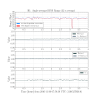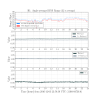As requested by Jeff and the calibration review committee, I've done a number of checks related to tracking the behavior of PCAL lines in the online-calibrated strain. (Most of these checks accord with the "official" strain curve plots contained in https://dcc.ligo.org/DocDB/0121/G1501223/003/2015-10-01_H1_O1_Sensitivity.pdf) I report on these review checks below.
I started by choosing a recent lock stretch at LHO that includes segments in which the H1:DMT-CALIBRATED flag is both active and inactive (so that we can visualize the effect of both gated and ungated kappas on strain, with the expected behavior that gstlal_compute_strain defaults each kappa factor to its last computed median if ${IFO}:DMT-CALIBRATED is inactive). There is a 4-hour period from 8:00 to 12:00 UTC on 30 November 2016 that fits the bill (see https://ldas-jobs.ligo-wa.caltech.edu/~detchar/summary/day/20161130/). I re-calibrated this stretch of data in --partial-calibration mode without kappas applied, and stored the output to
LHO: /home/aurban/O2/calibration/data/H1/
All data were computed with 32 second FFT length and 120 second stride. The following plots are attached:
- Timeseries of the ASD residuals of CAL-PCALY_RX_PD_OUT_DQ to GDS-CALIB_STRAIN (the online data with kappas applied) and TEST-CALIB_STRAIN (my recalibrated data without kappas), as computed at the PCAL lines (36.7, 331.9, and 1083.7 Hz).
- Overlayed median spectra of these three channels, zoomed in at each PCAL line.
- Overlayed ASD ratios zoomed in at each PCAL line.
- Full, overlayed median spectra of PCAL and the strian channels.
- A timeseries of the computed BNS range with and without kappas, compared against the behavior of each kappa (except the coupled cavity pole frequency, which is not applied online).
The script used to generate these plots, and a LAL-formatted cache pointing to re-calibrated data from the same time period but without any kappa factors applied, is checked into the calibration SVN at https://svn.ligo.caltech.edu/svn/aligocalibration/trunk/Runs/PreER10/H1/Scripts/TDkappas/. A similar analysis on a stretch of Livingston data is forthcoming.
I have re-run the same analysis over 24 hours of Hanford data spanning the full UTC day on December 4th (https://ldas-jobs.ligo-wa.caltech.edu/~detchar/summary/day/20161204/), during which time LHO was continuously locked. This time the lowest-frequency PCAL line has a PCAL-to-DARM ratio that improves when kappas are applied, which is the expected behavior. This suggests that whatever was going on in the November 30 data, where the 36.5 Hz line briefly strayed to having worse agreement with kappas applied, was transient -- but the issue may still be worth looking into.



























